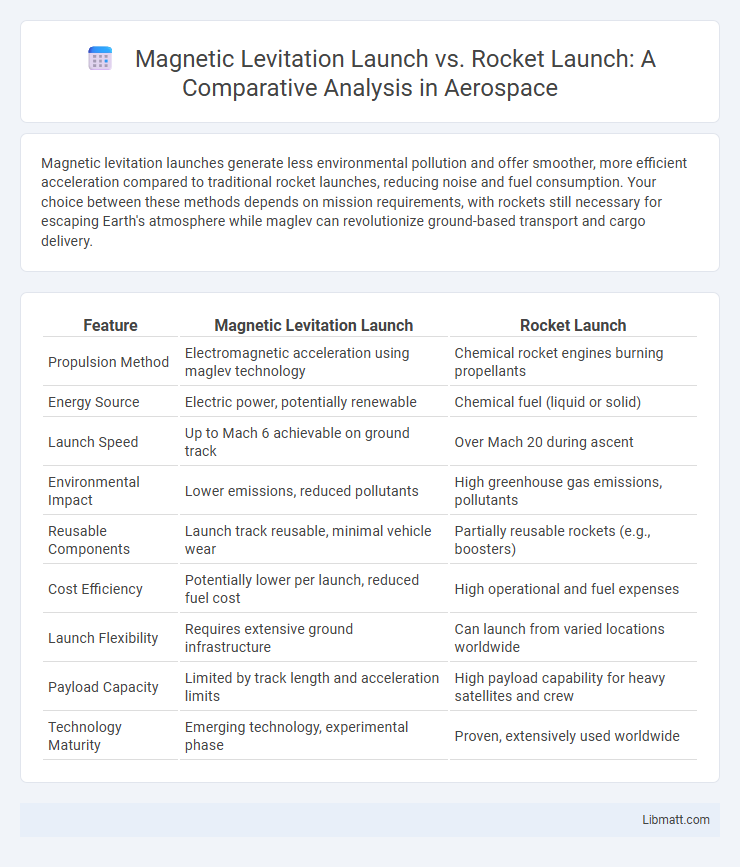Magnetic levitation launches generate less environmental pollution and offer smoother, more efficient acceleration compared to traditional rocket launches, reducing noise and fuel consumption. Your choice between these methods depends on mission requirements, with rockets still necessary for escaping Earth's atmosphere while maglev can revolutionize ground-based transport and cargo delivery.
Table of Comparison
| Feature | Magnetic Levitation Launch | Rocket Launch |
|---|---|---|
| Propulsion Method | Electromagnetic acceleration using maglev technology | Chemical rocket engines burning propellants |
| Energy Source | Electric power, potentially renewable | Chemical fuel (liquid or solid) |
| Launch Speed | Up to Mach 6 achievable on ground track | Over Mach 20 during ascent |
| Environmental Impact | Lower emissions, reduced pollutants | High greenhouse gas emissions, pollutants |
| Reusable Components | Launch track reusable, minimal vehicle wear | Partially reusable rockets (e.g., boosters) |
| Cost Efficiency | Potentially lower per launch, reduced fuel cost | High operational and fuel expenses |
| Launch Flexibility | Requires extensive ground infrastructure | Can launch from varied locations worldwide |
| Payload Capacity | Limited by track length and acceleration limits | High payload capability for heavy satellites and crew |
| Technology Maturity | Emerging technology, experimental phase | Proven, extensively used worldwide |
Introduction to Space Launch Technologies
Magnetic levitation launch systems use powerful electromagnets to accelerate spacecraft along a track, reducing the reliance on onboard fuel and decreasing launch costs compared to traditional chemical rocket launches. Rocket launches depend on rocket engines to produce thrust through combustion of propellants, offering precise control and the ability to reach orbital velocities but at significantly higher expense and environmental impact. Your choice between these technologies influences mission cost, payload capacity, and sustainability in space exploration.
What is Magnetic Levitation Launch?
Magnetic levitation launch employs electromagnetic forces to propel vehicles along a track at high speeds, significantly reducing friction compared to traditional rocket launches. This technology uses powerful magnets to lift and accelerate the vehicle, enabling efficient initial velocity without relying on onboard fuel. By minimizing energy loss through friction, magnetic levitation systems offer a cost-effective and environmentally friendly alternative for launching payloads into space.
How Traditional Rocket Launch Works
Traditional rocket launches rely on chemical propulsion, where fuel combustion generates high-speed exhaust gases to produce thrust according to Newton's third law. The rocket must carry both fuel and oxidizer, making its mass significantly high at liftoff, which limits efficiency and payload capacity. This process involves multiple stages that detach sequentially to reduce weight and maintain sufficient velocity to escape Earth's gravity.
Energy Efficiency Comparison
Magnetic levitation (maglev) launches consume significantly less energy than traditional rocket launches by reducing friction and utilizing electric-powered acceleration along a track. Rocket launches require massive amounts of chemical fuel to overcome gravity and atmospheric drag, resulting in higher energy costs and emissions. Your choice of maglev technology can lead to more sustainable and cost-effective space access with improved energy efficiency.
Environmental Impact Assessment
Magnetic levitation launches produce significantly lower greenhouse gas emissions compared to traditional rocket launches, as they rely on electric propulsion systems powered by renewable energy sources. Rocket launches contribute to atmospheric pollution by releasing carbon dioxide, water vapor, and black carbon at high altitudes, which can exacerbate climate change and damage the ozone layer. The assessment of environmental impacts highlights magnetic levitation as a cleaner alternative that minimizes noise pollution, chemical residues, and ecological disturbances associated with conventional rockets.
Cost Analysis: Maglev vs Rockets
Magnetic levitation launch systems significantly reduce operational costs compared to traditional rocket launches due to lower fuel consumption and reusable infrastructure. Rocket launches incur high expenses from propellant, complex manufacturing, and limited reusability of components, often reaching hundreds of millions of dollars per mission. Maglev technology offers scalable cost efficiency with reduced maintenance and energy requirements, positioning it as a more economical alternative for frequent payload deployments.
Payload Capacity and Scalability
Magnetic levitation launch systems offer higher payload capacity potential by reducing friction and allowing smoother acceleration compared to traditional rocket launches, which are constrained by fuel weight and aerodynamic stresses. Scalability of maglev launches is enhanced through modular track extensions and electromagnetic power adjustments, enabling gradual infrastructure expansion to accommodate larger payloads. Your choice between these technologies depends on mission requirements, with maglev providing cost-effective scalability and rocket launches offering established versatility for diverse payloads.
Technological Challenges and Limitations
Magnetic levitation launch systems face significant technological challenges including the development of ultra-precise control mechanisms to maintain stable levitation and acceleration, and the creation of powerful, energy-efficient electromagnetic tracks capable of handling extreme forces. Rocket launches encounter limitations related to fuel efficiency, thermal protection during atmospheric exit, and the complexity of staging systems needed for reaching orbit. Both methods require advancements in materials science and energy management to overcome current performance and cost barriers.
Future Prospects and Innovations
Magnetic levitation launch systems offer revolutionary advancements by reducing fuel consumption and increasing launch frequency through electromagnetic acceleration, potentially lowering costs compared to traditional rocket launches. Innovations in superconducting magnets and energy storage are driving the development of scalable maglev launch platforms, promising faster, safer access to space. Your investment in emerging maglev technology could position you at the forefront of a transformative shift in space launch logistics and sustainability.
Conclusion: Which Launch System Leads?
Magnetic levitation launch systems offer significant advantages in energy efficiency and reduced environmental impact compared to traditional rocket launches, which rely on high fuel consumption and produce substantial emissions. While rocket launches provide unmatched thrust and the capability to reach outer space directly, maglev technology excels in accelerating payloads with lower operational costs and less mechanical wear. Your choice depends on mission requirements, but for sustainable and cost-effective launches within Earth's atmosphere, magnetic levitation leads the way.
Magnetic Levitation Launch vs Rocket Launch Infographic

 libmatt.com
libmatt.com